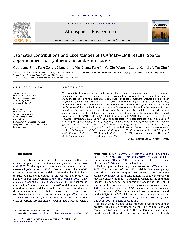摘要
The instability of a receptor model due to nearly collinear sources is often worsened by a large number of unknown sources, which usually results in unacceptable source contributions obtained by a single-stage model. To solve this problem, a combined (principal component analysis/multiple linear regression-chemical mass balance; PCA/MLR-CMB) model comprising two stages has been developed. In this study, synthetic datasets with a serious collinearity problem were generated to evaluate the performance of the combined model, and acceptable results were obtained in the presence of noise. Additional, the uncertainties of the estimated contributions were discussed. It was found that nearly collinear sources usually got higher uncertainties. Ambient data from Chengdu were then studied using both the PCA/MLR-CMB and NCPCRCMB models. For PCA/MLR-CMB model: vehicle exhaust emissions contributed 80.46 mu g m(-3) (28.71%) to the total PM(10); coal combustion got 68.52 mu g m-3 (24.45%); resuspended dust, soil dust, secondary sulfate, secondary nitrate, cement dust and smelters got 53.91 mu g m(-3) (19.24%), 46.31 mu g m(-3) (16.53%), 33.35 mu g m(-3) (11.90%), 17.65 mu g m(-3) (6.30%), 12.47 mu g m(-3) (4.45%) and 1.81 mu g m(-3) (0.65%), respectively. For NCPCRCMB model, the results were: vehicle-86.70 mu g m(-3) (30.94%), cement-49.47 mu g m(-3) (17.65%), resuspended dust-41.22 mu g m(-3) (14.71%), coal-30.43 mu g m(-3) (10.86%), soil-27.45 mu g m(-3) (9.80%), secondary sulfate-16.41 mu g m(-3) (5.86%) and secondary nitrate-3.61 mu g m(-3) (1.29%).
- 出版日期2011-6
- 单位南开大学
